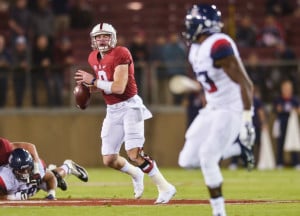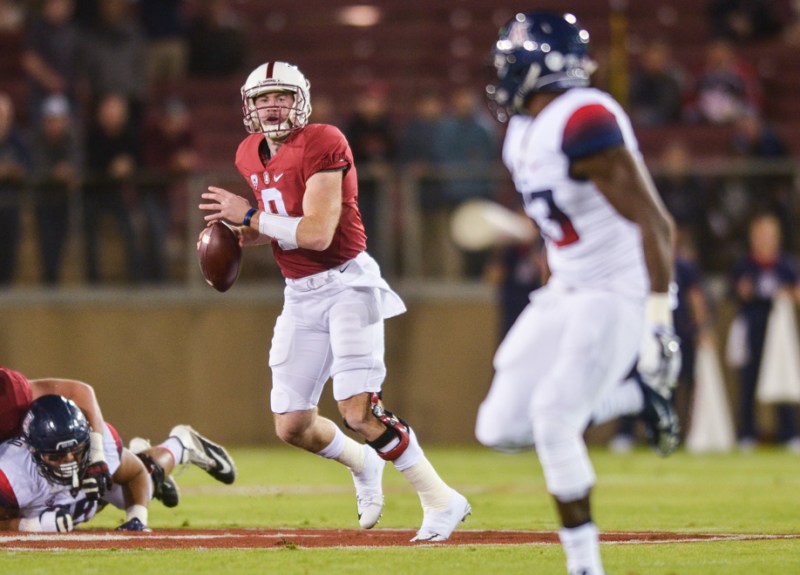In preparation for Stanford’s Thursday night matchup against the UCLA Bruins, The Stanford Daily’s Do-Hyoung Park (@dohyoungpark) had a chance to ask a few questions of Matthew Joye (@mattjoye), the lead football writer at The Daily Bruin, in order to get an insider’s perspective on UCLA football and the state of the program as it arrives on The Farm seeking to snap its seven-game losing streak to the Cardinal.
The Stanford Daily (TSD): Stanford has a seven-game winning streak against UCLA coming into this matchup, and a lot of UCLA fans bemoan the fact that they seem to get “Good Kevin Hogan” every year. Especially given the recent history between these teams, does this game have any added meaning for the team and fans?

Matt Joye (MJ): Coach Jim Mora said on Tuesday morning that he isn’t treating this game differently than any others, but there’s an overwhelming sense that this game really does have more significance than all the other games on UCLA’s schedule. Just consider what junior outside linebacker Deon Hollins said on Sunday: “The wrong thing to do would be just to forget about [the Stanford losses].”
Hollins added that the Stanford game is – in his opinion – the biggest game on UCLA’s schedule thus far, and one that the Bruins must win to “get over the hump” in the Pac-12.
As for the fan base, a win over Stanford would mean as much as anything other than a win over USC. Obviously wins in the postseason are the most important, but Stanford has been the team that’s held UCLA back from bigtime postseason accomplishments in two of the past four seasons. So the Bruins really want to win this game just to bury those memories and get the monkey off their backs.
TSD: Jim Mora has certainly been a great coach in his time in Westwood, but he can’t seen to get the team over that cusp from “great” to “elite.” This year looked like UCLA’s year, but a tough loss to ASU and Utah’s dominance obviously make that outlook a lot bleaker. How does the ASU loss change your outlook for the season?
MJ: The Arizona State loss really doesn’t change the outlook of the season much. As you know, Ohio State lost to Virginia Tech early last season and went on to win the national championship. So UCLA can recover from the loss to Arizona State by winning from here on out.
What the Bruins can’t recover from are all the injuries they’ve sustained. UCLA has lost three starters – and one potential All-American – on defense, making one of the team’s strong points into a glaring question mark. But going back to your original question, I think the loss to Arizona State helps UCLA if anything, as a way of humbling the team and possibly increasing its motivation heading into the Stanford game.
TSD: Let’s talk Josh Rosen. He’s looked great at times; he’s looked freshman-like at times. How much have you been able to glean about his ability from the early returns this season? Can he be the quarterback to lead this year’s UCLA team to greatness?
MJ: Rosen has actually looked a lot less freshman-like than people say. Of course, his three-interception performance in the first half against BYU caused a lot of concern, but Rosen has made very few mistakes since then.
He’s done a great job of handling the blitz – best evidenced last week, when he threw his two touchdown passes against a rush of five men or more – and his arm strength and accuracy are really impressive. Sure, Rosen went only 22-for-40 last week against ASU, but five of his passes were dropped, two were thrown away and three were batted down. Take those throws out of the equation, and Rosen had an adjusted completion percentage of 79.4 percent.
Overall, Rosen definitely looks like the kind of quarterback who can lead UCLA to a Pac-12 Championship – and maybe more – in the years to come. It will be interesting to see if he can get his first upset win this week against Stanford.
TSD: Stanford’s defense hasn’t been great this season, but it’s been good enough. It’ll take a lot of mistake-free, consistent ball from opposing offenses to beat it because Stanford’s defense is more fundamentally sound than playmaking, but Rosen has had his share of turnover issues this year as well. Can he lead an offense in that way?
MJ: The key for UCLA will be whether it can get the run game going with tailback Paul Perkins – the Pac-12’s reigning rush leader. As offensive coordinator Noel Mazzone said a couple weeks ago, that’s UCLA’s “comfort zone.”
The only problem is that opposing teams have started to catch on to UCLA’s run-first strategy, and the Bruins have been left with a lot of third-and-longs as a result. If the Bruins can’t find a way to get productive first-down plays with their running game, Rosen will have a much greater chance of turning the ball over. And, like you said, Rosen has had problems turning the ball over at times.
So, in sum, if the Bruins are productive on first and second down – and minimize their number of passing downs – then they could have a chance. If not, it could be another long day for UCLA.
TSD: Even with a depleted defensive line, Stanford’s front seven has held the likes of Tre Madden to 64 yards, Storm Woods to 35 yards and Nick Wilson to 46 yards. How do you like Paul Perkins’ chances?
MJ: Perkins’ chances really depend on Mazzone’s play-calling. Like I said earlier, opposing teams have started to catch onto Mazzone’s pattern of running the ball on first down early on, and Perkins’ stats have taken a hit as a result.
After the loss to Arizona State, Mazzone even admitted that he was “forcing the issue” a bit with the running game. So if Mazzone opens the playbook early on – like he did on the first play of the season against Virginia – Perkins will probably have a better chance at success. The redshirt junior has great vision and shiftiness, but if there’s no hole for him to run in, he’s not the kind of guy that will cut back and forth across the field like Barry Sanders, Sr.
TSD: It appears as if Stanford’s offense has finally arrived, with the offensive line hitting its stride to pave the way for a great running game and Kevin Hogan realizing his potential as a brutally efficient pocket-passer, even with a bum leg. Can UCLA’s defense fare any better than those of USC, Oregon State and Arizona without Eddie Vanderdoes, Myles Jack or Fabian Moreau?
MJ: Believe it or not, I think UCLA is better fit to defend an interior-running team like Stanford than a spread offense team. This year, the Bruins’ main defensive problems have come when they’ve faced the read-option, and the Cardinal don’t rely on that play at all. UCLA’s defensive line is strong – even without Vanderdoes – as junior Kenny Clark is one of the best nose tackles in the country. The linebacker unit is definitely prone to mistakes in run coverage – allowing 353 rush yards to Arizona – but performed a little better last week against Arizona State.
The problem that the Bruins have had is with finishing: Arizona State had 157 yards after contact last week, as UCLA failed to wrap up on several tackles. I think that problem will persist into this week, with the Bruins hanging tough for two or three quarters, but wearing down in the fourth.
The reason I spent so much time diagnosing UCLA’s run defense is because I think that will be the key to this game. Stanford ranks No. 7 in the nation with an S&P+ rating of 129.8 on standard downs. In contrast, the Cardinal are No. 59 in the nation with an S&P+ rating of 109.0 on passing downs. So if UCLA can find a way to stop Stanford’s run plays and force a high number of passing downs, the Bruins could have a chance.
TSD: Last I checked, Stanford is favored by 5.5 points at home. How does that sound to you? What will be the most important matchup in the game, and how do you see things playing out? What does UCLA need to do to pull out its first Stanford win in over a half-decade on Thursday?
MJ: The 5.5-point spread seems about right to me, although I can see UCLA losing by two to three touchdowns.
The key to the game will be first-down efficiency on both sides. The Bruins struggled mightily against the Sun Devils because they couldn’t get anything going on first down, leading to multiple third-and-long situations. Those third-and-longs led to a lot of three-and-outs, and poor field position for UCLA throughout the game.
On the other side of the ball, UCLA will need to defend well on first down to have a chance. As noted in question No. 6, Stanford is at its weakest offensively when it is faced with passing downs – but thrives on standard downs. So if the Bruins can stuff the run on first down, then they will have a chance to take advantage of the Cardinal’s weakness. If not, then UCLA will be playing on its heels for the whole game and Stanford will repeat history, throwing yet another Bruin season out of national contention.
Contact Do-Hyoung Park at dhpark ‘at’ stanford.edu.
